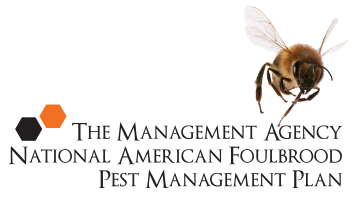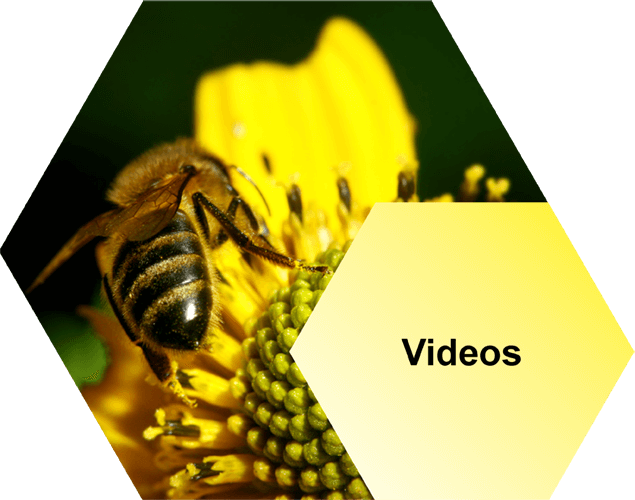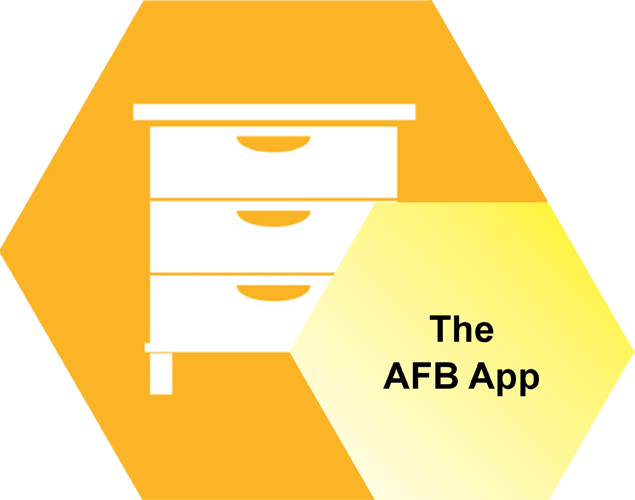Hive quarantine
What is hive quarantine?
Hive quarantine is where each honey bee colony is managed by itself, with no interchange of equipment between hives. It is usually only employed where there is a significant risk of equipment that might be swapped between colonies being contaminated with AFB spores (i.e. where the outfit has a very high incidence of AFB).
As an example, consider a beekeeper who has a 20% AFB incidence, and therefore decides to impose hive quarantine. To do so, the beekeeper must isolate and keep together all beehive equipment associated with each honey bee colony.
Example of hive quarantine
The beekeeper starts by assigning a unique number to each hive, which is permanently recorded on a piece of equipment that is likely to always stay with that colony. A good choice is to put the number on the floor board, since it is rarely swapped between colonies.
Small animal ear tags can be nailed on the front of each bottom board where they can be easily seen. From then on, no equipment is swapped between colonies. Queen excluders, feeders, division boards, etc., either stay with the colony, or if they are taken away for storage, they are marked with the unique number using a felt-tip pen. When the pieces of equipment are needed again, they are only put on the hive with the unique number.
Honey supers are also numbered when removed. The frames are extracted together and are put back into the same super. If keeping track of the frames during extraction is a problem (because a large capacity extractor is being used), several cans of spray paint are kept at hand in the extraction shed. Before extraction, a coloured line is drawn across the top bars of the frames in the box, and the box is also marked with a dot of the same colour paint. No boxes containing frames with the same colour are put into an extractor batch, and no frames of another colour are put back into the box.
If AFB is found in any hive, the stored equipment marked with that hive’s unique number is located, frames are destroyed, and all other equipment is sterilised.
This total destruction policy may seem harsh. However, faced with a bad AFB outbreak in the spring, many beekeepers have wished that they could identify the honey supers that came off those infected hives the previous autumn.
Hive quarantine is obviously very time consuming, and requires the beekeeper to be highly organised. It lends itself more to hobbyist beekeepers, and beekeepers with smaller hive holdings. However, the time taken to implement hive quarantine can be less than first imagined has been used by some commercial beekeeping operations, with dramatic effects.
When the hive quarantine is in place, and the honey supers are on the hives, a starting point exists where no further AFB hives are going to be created. The work then involves inspecting all hives at regular intervals and destroying all equipment associated with any hive found to be infected. Hives must also be well-managed and fed so that as few hives as possible either starve or become queenless. It is far more difficult to determine the disease status of hives that die out.
If all the available equipment is used on the hives each year, if comprehensive inspections are carried out, and if there are few outside sources of infection such as neighbouring apiaries or feral colonies, it should be possible using hive quarantine to eliminate AFB from almost any sized outfit within a couple of years.
Hive quarantine can also be used for colonies that return a positive culture test, but have no clinical disease symptoms. In this case, the hive and its equipment should be isolated and treated separately until it returns a negative test. If there are a number of hives testing positive, they can all be moved to the same apiary to reduce the possibility of these hives cross-infecting other colonies in the outfit.
Take the AFB 5 minute quiz
How well do you know what you need to know about AFB and beekeeping? Take our short quiz and find out.
Videos
Our videos cover everything from your legal obligations to how to recognise AFB, collecting cell and bee samples and more.
Symptoms
There’s a lot of good information here, telling you everything you need to know about recognising AFB: the visual symptoms, smell of AFB and more.
Inspection and Diagnosis
Successfully eliminate AFB by telling the difference between symptoms of AFB and other brood diseases in the hive. We tell you the best methods for inspecting your hives.
The Law
New Zealand beekeepers have a number of legal obligations that must be met regarding AFB disease. Read the shortened list in summary, here.
Elimination
Most hives become infected because bees, honey or equipment have been put into a hive from another hive that is infected with AFB. Lower your chances of an AFB infection by reading this section.
AFB Recognition Course Info
Find out when the next AFB Recognition and Competency Courses, or Refresher Courses are available. These are held throughout the year in various New Zealand locations across the South Island and North Island.
The AFB App
Follow the link below to open the App. Once open to save to your device you need to bookmark the URL on your phone so you can find it easily again. Please click here to open.








